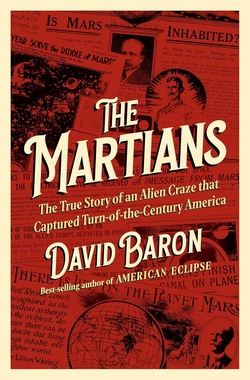Centauri Dreams
Imagining and Planning Interstellar Exploration
Toward a Census of Earth-Sized Worlds
While transit and radial velocity methods get most of the press when it comes to finding exoplanets, gravitational microlensing offers an independent alternative. Here a star passes in front of a far more distant object, causing the light from the source to be gravitationally ‘bent’ by the intervening star. The useful thing for exoplanet work is that if the ‘lensing’ star is orbited by one or more planets, they can leave their own signature in the microlensing event. And indeed, microlensing collaborations like MOA (Microlensing Observations in Astrophysics) and OGLE (Optical Gravitational Lensing Experiment) have made the method pay off in exoplanet discoveries.

Image: Gravitational microlensing relies on chance line-ups between an intervening star with planetary system and a more distant light source. Credit: California Institute of Technology.
Now researchers at the University of Auckland are proposing to measure low-mass planets, planets as small as the Earth, using these methods. Microlensing events vary in terms of the degree of magnification they provide, with both MOA and OGLE finding some events with extremely high magnifications. You would think the higher the magnification, the better, but this turns out to be not necessarily the case, as the university’s Phil Yock and colleagues explain in a new paper. Their simulations clarify the methods we can use to detect Earth-sized planets:
Our conclusion is that low-mass planets can be e?ciently searched for in events with moderately high magni?cations of order 50-200, and that the greater frequency of these events in comparison to those with higher magni?cations lends advantage to monitoring them. However, to take full advantage of their discovery potential, telescopes with apertures in the range 1-2m would be needed to photometer them with su?cient precision to detect low-mass planets.
A network like this is, in fact, being deployed by the Las Cumbres Observatory Global Telescope Network, working in collaboration with SUPA/St Andrews (Scottish Universities Physics Alliance). These are 1- and 2-meter instruments, with three telescopes each in Chile, Australia and South Africa, and one each in Hawaii and Texas. Working with a telescope in the Canary Islands and supplementing its data with several other southern hemisphere instruments, the network, according to Yock and colleagues, ought to be able to help us not only detect Earth-sized planets but measure them at substantial distances from their star. Says Yock:
“Our proposal is to measure the number of Earth-mass planets orbiting stars at distances typically twice the Sun-Earth distance. Our planets will therefore be cooler than the Earth. By interpolating between the Kepler and MOA results, we should get a good estimate of the number of Earth-like, habitable planets in the Galaxy. We anticipate a number in the order of 100 billion.”
It’s an intriguing idea. The Kepler effort is all about developing a statistical read on how often Earth-class planets occur in the galaxy by looking at a huge number of stars. Yock’s work demonstrates that low-mass planets can come out of microlensing observations through continuous network monitoring. The paper notes that in recent times, about 10 events with magnifications over 200 have been detected by MOA and OGLE every year. Dropping the magnification requirement to 50 should quadruple the detection rate, allowing us to develop an independent check on measurements made by radial velocity and transit studies.
Consider how useful microlensing can be. We are not burdened, as with radial velocity and transits, with a measurement more sensitive to larger worlds closer to their host stars. The planets thus far detected through microlensing have had masses ranging from a few Earth masses to a few Jupiter masses, while their separation from their hosts has been on the order of several AU. This provides, says the paper, ‘a representative sample of the distribution of planets between us and the centre of the Galaxy that orbit a relatively unbiased sample of host stars.’
Thus we can supplement other ways of estimating the abundance of cool planets in the Milky Way by developing a statistically significant sample of detections through the kind of microlensing events Yock describes. The paper is Abe et al., “Extending the Planetary Mass Function to Earth Mass by Microlensing at Moderately High Magni?cation,” accepted for publication at Monthly Notices of the Royal Astronomical Society (preprint).

Clarke: The Rocket Man Emerges
In the 1950s, Arthur C. Clarke’s fame had begun to spread, and he sometimes referred to himself, genially enough, as an ‘unemployed prophet.’ This is a period in Clarke’s career that, from 1953 to 1956, saw the emergence of the fifteen tall tales that would be published in 1957 as Tales from the White Hart, a fictitious pub modeled after London’s White Horse. But while the stories were extravagant, the setting was the perfect amalgam of Clarke’s interest, for the White Horse was where science fiction met rocketry for his extensive network of friends.
One habitué of the White Horse was Ken Slater, whose recollection of those meetings appears in Neil McAleer’s Visionary: The Odyssey of Sir Arthur C. Clarke (2013):
“Anybody new that came to the pub was always told to ask Arthur to tell them about rockets, you see. Which they would do and then sit back for the short lecture. After Arthur broke into the short lecture, then we’d always strongly advise the newcomer to ask, ‘Look, what does the rocket push against?’ Which immediately brought forth from Arthur the long lecture, you know, the five-guinea version. That was a standard put-on at the White Horse, because if you ever got Arthur on rocketry, you could sit back and let the bar listen for up to a couple of hours.”
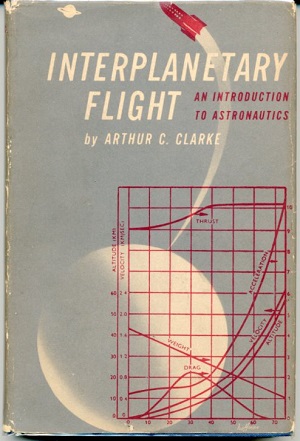
By now Clarke was well established in science fiction, with credits like The Sands of Mars (1951) and Childhood’s End (1953), along with short story collections like 1953’s Expedition to Earth. But as McAleer notes, it was science writing rather than science fiction that had made him realize it was time to become a full-time writer. The spur was a contract with Temple Press in 1949 for a nonfiction book called Interplanetary Flight, which drew heavily on a two-part paper he had published in separate magazines in previous years. The book presented spaceflight for the general reader, though the more technical minded could find Clarke’s equations tucked neatly away in the appendix.
The Science Writing Breakthrough
Now emerges Clarke the educator, a rocket scientist with a bent for philosophy who saw the exploration of space as both a physical and a spiritual quest. Carl Sagan would call Interplanetary Flight ‘a turning point in my scientific development,’ and technology in service of the human spirit became Clarke’s idée fixe, the principle that would hold humanity together by offering it challenges that summoned up all its reserves of intellect and courage. Soon Clarke’s American editor George Jones would encourage him to write 1952’s The Exploration of Space, which was bought by the Book of the Month Club.
Clifton Fadiman, for years one of the BOMC’s judges, met Clarke on the first of the author’s trips to the United States. McAleer quotes him on a meeting at the Plaza Hotel:
“The Oak Room is a rather worldly rendezvous. Mr. Clarke is not worldly; he is otherworldly. He spoke of space satellites, lunar voyages, interplanetary cruises, as other men would discuss the market or the weather. As he explained how within a decade three space stations whirling in an orbit about the equator will make possible (indeed one fears inevitable) simultaneous world-wide television broadcasting, our right-hand neighbor (a vice-president of CBS) went into a kind of catalepsy.
“To understand a mind like Mr. Clarke’s we must realize that during the last fifty years, more especially the last twenty-five years, virtually a new mental species has emerged among us. They are the men who in a real sense live in the future, men for whom the present is merely a convenient springboard.”
If you’ll go back to the first of these articles on Clarke (The Vision of Arthur C. Clarke), you’ll see in the second photo there that Clarke is wearing under his jacket a T-shirt that Gregory Benford gave him. The text is barely readable, but if you look closely, you’ll see that it says “I invented the communications satellite, and all I got for it was this lousy T-shirt.” Fadiman remembers Clarke’s enthusiasm for the idea in 1952, but it would indeed make him little money.
As his stint in the Royal Air Force drew to a close in 1945, Clarke developed the notion of geostationary satellites providing global communications. During the war he had worked on microwaves and radar, while his passion for rocketry provided the means of deployment. McAleer points to George O. Smith as a possible influence, the latter having published a series of stories in Astounding during the war years that became known as the Venus Equilateral series. Clarke even wrote an introduction to a 1976 reprint of these stories saying that they might well have influenced him subconsciously in his work.
The article “Extra-Terrestrial Relays,” whatever its sources, would appear in Wireless World in October of 1945. Worldwide coverage by radio and television would be implemented by a series of spacecraft with an orbital period of 24 hours at a distance of 42,000 kilometers from Earth center. Clarke went on to describe the equatorial orbits that would place space stations into ‘fixed’ spots in the sky (as seen by people on Earth). The predictions were bold, valid and, yes, visionary, but remained unheralded at the time except by the US Navy. Many believe the article was influential in the development of early space satellites.
Clarke’s $40 from Wireless World offered him plenty of opportunity later in life to joke about the real monetary value of the communications satellite concept, and McAleer notes that he never showed any regrets about what might have been. In any case, being a visionary was already becoming a habit for the writer, one that seemed to outweigh financial considerations. While still in the RAF and working as an instructor at a radio school in Wiltshire, Clarke often broke into soliloquies on rocket science, describing at one late night session how multistage rockets would get us to the Moon. When asked how big the rocket would be, he described it as the height of St. Paul’s Cathedral, which turns out to be within a few feet of the height of the Saturn V.

Image: With Walter Cronkite (L) and Wally Schirra (center), Arthur C. Clarke takes part in CBS coverage of Apollo 11’s return to Earth on July 24, 1969. Credit: CBS:Landov.
The Pleasures of Re-Reading
The twin themes of Clarke’s life — the future as depicted in science fiction and the technology that would get us there — were fully in place by 1950. For the rest, for Sri Lanka and 2001 and the space elevator, for the increasing fascination with the ocean and diving expeditions among the Pacific coral, for the Apollo coverage with Cronkite and the extraterrestrial interloper called Rama, I send you to McAleer’s book. But I also send you emphatically back to Clarke himself. I’d begin a re-read of the man with his short stories, probably starting with Expedition to Earth and moving then to Childhood’s End. I’d look anew at The City and the Stars and them make a point of picking up The Songs of Distant Earth, a few thoughts on which will close this piece.
The Songs of Distant Earth came out of Clarke’s speculations on using an interstellar rather than an interplanetary setting, and the genesis of the book was a short story written in 1957, the year of Sputnik. Thirty years later he would begin the novel of the same name, one he would always consider his best work. Clarke took his crew to a planet 50 light years away, traveling in hibernation at ten percent of the speed of light. Judy-Lynn del Rey would publish the book in 1987, a hard science fiction tale that at its kernel contained a love story. McAleer says this:
Thematically, as in much of Clarke’s fiction, the novel addressed humanity’s quest for purpose and immortality in contrast to the individual’s inevitable death. The loneliness of man is intensified against the backdrop of cosmic space and the finiteness of human time. Even if the survival of Homo sapiens is assured through interstellar travel, are not individuals doomed even as they embrace in love and light to keep the fall of night at bay? Clarke’s “songs” are not as joyous and uplifting as we might first expect. Always present in the novel is the feeling of insurmountable separation across the voids of space, time, and death.
Clarke tried to pull out all the stops here — he was sensitive to the charge of flat characterization and wanted to counter it, and The Songs of Distant Earth demonstrates he had it in his power to do that, though reading the book I can sense how hard the effort must have been. For Clarke’s characters are, for the most part, drawn to serve a plot purpose, and in the bulk of his fiction, we see character used the way the writer and critic James Gunn thinks it should be used in science fiction, as a way of creating a representative humanity in which the important work — the ideas of the tale — can be made manifest by the character’s reaction to them.
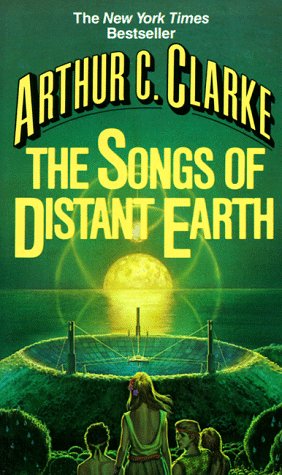
That can still make for powerful fiction, but you can see from the characters in The City and the Stars that their very flatness of affect is the result of their situation, living a changeless life in the eternal city. Or think of Keir Dullea and Gary Lockwood in 2001: A Space Odyssey, where the difference between humans and their technology is not always apparent, the crew of Discovery sometimes seeming as robotic as Hal himself.
None of this matters when, as did Stapledon, Clarke takes our imagination into the deep future and rotates our view back around to see what our world looks like from that perspective. He was dismissive of the idea that science fiction is nothing but escapism, telling Alice Turner:
“It’s hard to define science fiction these days, especially since the mainstream seems to be moving in that direction. Traditionally, it’s been a form that offered a good story, and I suppose you could call that escapism, in a positive sense. C.S. Lewis, who wrote it himself, said, ‘The only people who think there’s something wrong with escapism are jailers.'”
But I also like what he told Alan Watts: “The purpose of the universe, Alan, is the perpetual astonishment of mankind.” Clarke was a writer who thought not in terms of years but of aeons, and not so much of individual humans as of the species. Re-reading Clarke, then, should also take us to his collected non-fiction, the hefty volume called Greetings! Carbon-Based Bipeds (1999). Here the twin strands of Clarke’s work come together, a lifetime of enthusiasm for and optimism about technology and the deep spaces to which it can take us all.
Addendum: The Rosetta Books ebook edition of Visionary, Neil McAleer’s revised biography of Arthur C. Clarke, is now available through Amazon.

Arthur C. Clarke: On Cities and Stars
I’ve always wondered how Arthur C. Clarke coped with the news he received in 1986, when doctors in London told him he was suffering from amyotrophic lateral sclerosis, a terminal illness that in the States is often called Lou Gehrig’s disease. The diagnosis was mistaken — it turns out Clarke actually suffered from what is known as ‘post-polio syndrome,’ a debilitating but not fatal condition. For two long years, though, he must have thought through all the symptoms of ALS, knowing that the degenerative motor neuron breakdown could gradually sap him of strength and movement. How would such an energetic man cope with an agonizing, slow fade?

Neil McAleer’s revised biography (Visionary: The Odyssey of Sir Arthur C. Clarke) gives the answer, as recounted by Clarke’s brother Fred:
“…after the initial shock, Arthur more or less said, damn it, he’d got an enormous amount he wanted to do, and if he’s only got fifteen months to do it, he’d better whack into it. And he did whack into it, and the next year he produced four books.
“Eighteen months later he was still writing, and all the horrible things they told him might happen hadn’t happened to him. Of course they had told him all the things he should do to keep it under control—what diets to take and what exercises to do, which he very religiously did. He carried on working intensely and produced an enormous amount of work, which might have been the saving grace. If he had been the sort to say, ‘Oh my God, I’m going to die in fifteen months,’ he probably would have…”
That story speaks volumes about the man, identifying a resolve that kept him working despite his other ailments into his nineties. It also tells me that he was able to place himself mentally in a context that weighed a single human life against the broad movement of history. I think Clarke was happy to see himself as someone who instigated currents of thought, changed perspectives and launched careers. He did these things for people of all ages both by the example of his own life and by the lives he created in fiction that showed us what humanity might become.
Young Writer at Work
By the time Clarke moved from Somerset to London in 1936 he was already suffused with science fiction and in particular enraptured with Olaf Stapledon’s Last and First Men, not to mention the second-hand copies of American science fiction magazines that were then available in England. He spoke of the ‘ravenous addiction’ these magazines inspired and the effect that Stapledon’s novel, with a time scale spanning five billion years, had upon his imagination. He was twelve years old when he first read Last and First Men, awed by its cosmic reach and its placement of the evolution of humanity against the broader backdrop of the cosmos.
Think for a moment of 2001: A Space Odyssey. Has any film ever covered a wider swath of time, from the beginnings of tool making to the apotheosis of the species in an extraterrestrial encounter? This was Clarke’s stage, but the other great discovery of his youth, David Lasser’s The Conquest of Space (1931) gave him the technology he would spend a life examining. Lasser was the founder of the American Interplanetary Society (which became the American Rocket Society and, eventually, the American Institute of Aeronautics and Astronautics). He was also, for a time, the editor of Hugo Gernsback’s Science Wonder Stories and Air Wonder Stories. If Stapledon brought Clarke the cosmos, Lasser gave the boy a focus on the attainable, the idea of space as a reachable frontier.
In London, Clarke had a tiny flat in Norfolk Square and was soon co-editing (with science fiction writer William Temple) the fanzine Novae Terrae, whose editorial sessions were so cramped in Clarke’s quarters that Temple once said “…there was hardly room for the two of us, and A[rthur]’s Ego had to be left outside on the landing.” Clarke’s nickname of Ego derives from this period when Temple and Clarke both discovered the latter’s competitive nature. I think McAleer is right in stressing, though, that Clarke’s volubility was largely the result of his enthusiasms. This was a man who loved, above all else, the communication of an idea.
Into the Remote Future
For those keeping score, Novae Terrae would soon become, under the editorship of Ted Carnell, the influential magazine New Worlds. But in the days just before World War II, while working on issues of Novae Terrae and assorted publications for the British Interplanetary Society, Clarke found time to begin developing his first novel from ideas that had come to him back in Somerset. “Against the Fall of Night” would appear in an early version in Startling Stories in November of 1948, but that hardly ended the tale. Clarke kept rewriting the story, seeing it into print as a novel from Gnome Press in 1953 and then putting it through a major revision as The City and the Stars, published in 1956.

I seldom think of Clarke as a reader of poetry, but he clearly knew his Housman:
Here, on the level sand,
Between the sea and land,
What shall I build or write
Against the fall of night?
The words are from Housman’s poem “Smooth Between Sea and Land.” Maybe the idea of long stretches of sand and a metaphorical night that comes to us all fired his imagination. I came across The City and the Stars just a few years after it was published and was mesmerized by its setting in much the way Clarke was taken with Stapledon’s Last and First Men. Here was Diaspar, the city of the far future, the only city on planet Earth, whose inhabitants moved through a high-tech monument to stasis. Nothing changes in Diaspar even as the world around it loses its oceans and becomes desert. Clarke would have much to say about the kind of inward thinking that his characters have to overcome, but the unmistakable fact about Diaspar is that the city at the end of time is also achingly, eerily beautiful.
Here’s science fiction writer Jo Walton on the book, nailing its essential allure:
The plot is quite simple. Diaspar is beautiful but entirely inward turned. Alvin looks out and discovers that there is more in the universe than his one city. He recovers the truth about human history, and rather than wrecking what is left of human civilization, revitalises it. By the end of the novel, Man, Diaspar, and Earth have begun to turn outward again. That’s all well and good. What’s always stayed with me is the in-turned Diaspar and the sense of deep time. That’s what’s memorable, and cool, and influential. Clarke recognized though that there isn’t, and can’t be, any story there, beyond that amazing image. It’s a short book even so, 159 pages and not a wasted word.
As to its author, I love the way he could never let this book go. It was, after all, his first novel, and as such it was perhaps the most deeply inspired by the reading of his youth. When he wrote a new preface to it in 1955, he noted that developments in information theory encouraged him to re-think the future course of humanity, a revision that would lead, says McAleer, to a whopping seventy-five percent new prose. The man was indefatigable; he couldn’t let go when ideas seized him, and when he had the wind behind him, no horizon was too far to strive for.
Restless Thoughts from Orbit
On the same visit to the United States in which he met Neil McAleer and learned that he did not have ALS after all, Clarke visited the National Air and Space Museum with Gregory Benford, long-term colleague Fred Durant and Hector Ekanayake, whose friendship with Clarke in Sri Lanka spanned decades. Benford noted the lack of long-term perspective in much contemporary science fiction and pointed out that The City and the Stars had been written before the discovery of DNA, so biology made no significant appearance in the story. Benford and Clarke’s Beyond the Fall of Night (1990) would be the result of that conversation.

McAleer’s biography gives the details on all of Clarke’s books, but my childhood fascination with The City and the Stars has kept me focused on the early stages of Clarke’s career in London and the ideas that began germinating both there and earlier in Somerset. The Signet paperback illustrated here is not the edition I first encountered, but I have to run it because of my love of Richard Powers, whose cover art appeared in so many paperbacks from this period. In this case, Powers’ surreal images go far toward capturing the timeless allure of the city in the desert.
The letters that McAleer has access to offer insights from Clarke’s old associates, and some new ones as well. In 2006 a British engineer named Nicholas Patrick was about to fly on a Space Shuttle mission, Discovery STS-116. He wrote Clarke to invite him to the launch, telling him he had been reading Clarke’s books since growing up in London. Due to his health problems, Clarke was unable to appear, though he wrote an enthusiastic response thanking Patrick, who replied:
“I am sad to hear that you will not be able to attend the launch, but understand completely given the circumstances. Perhaps instead, if you are willing, I might email you from orbit. “A month ago I reread The City and the Stars, perhaps my favourite book, and was again drawn by the ideas in it. Ever since I first read it, I have wanted to find an old spaceship and travel to distant suns. I shall be very happy in low earth orbit, but I don’t think it will completely satisfy me.”
And that’s the thing: Anyone who has grown up with The City and the Stars is going to find even the wonders of Earth orbit a bit tame. Clarke was always at his best as a science fiction writer when taking the long view. His characters would learn to burst free from Diaspar, but its very conception is as staggering and poetic as anything he ever wrote. From the book:
Here was the end of an evolution almost as long as Man’s. Its beginnings were lost in the mists of the Dawn Ages, when humanity had first learned the use of power and sent its noisy engines clanking about the world. Steam, water, wind-all had been harnessed for a little while and then abandoned. For centuries the energy of matter had run the world until it too had been superseded, and with each change the old machines were forgotten and new ones took their place. Very slowly, over thousands of years, the ideal of the perfect machine was approached – that ideal which had once been a dream, then a distant prospect, and at last reality: No machine may contain any moving parts. Here was the ultimate expression of that ideal. Its achievement had taken Man perhaps a hundred million years, and in the moment of his triumph he had turned his back upon the machine forever. It had reached finality, and thenceforth could sustain itself eternally while serving him.
Thus Clarke’s description of the computer that runs Diaspar free from all human intervention. What continues to confound me about Clarke is what McAleer brings out so well, the duality between an imagination capable of transcending time and the canny engineering horse-sense that spawned near-term space achievements. This is the man who dreamed up communications satellites when not dreaming of eternal cities of the far future. Tomorrow, then, let’s look at Clarke the space pioneer.

The Vision of Arthur C. Clarke
In a 1955 letter to the British rocket scientist Val Cleaver, Arthur Clarke wrote about his view from the island then called Ceylon:
“Beautiful night last night. Southern Cross (a very feeble constellation) just above the front gate, with Alpha Centauri beside it. It always gives me an odd feeling to look at Alpha and to realize that’s the next stop.”
The next stop indeed. Cleaver was a fellow member of the British Interplanetary Society who, like Clarke, was instrumental in energizing the society after World War II. Both men served the BIS as its chairman in those years, and after Cleaver’s wartime work at De Havilland, he would go on to start a rocket division for the company and become chief engineer for the rocket division of Rolls-Royce. He is perhaps best known as the man behind the Blue Streak missile, but for those with a passion for the works of Arthur C. Clarke, he will always be remembered for his deep friendship with the man, and his energetic contribution to British thinking on space travel.

Image: Arthur C. Clarke and Val Cleaver at Warwick Castle in August of 1973. Credit: British Interplanetary Society.
Neil McAleer’s new book on Clarke is called Visionary: The Odyssey of Sir Arthur C. Clarke (Clarke Project, 2012). It’s the place to go for the background on this period, and on any period, in Clarke’s life. I call the book ‘new,’ but it’s actually a major revision and update of McAleer’s 1993 biography that adds extensive coverage of Clarke’s last fifteen years, covering a lot of material that was new to me, including insights into Clarke’s synergistic relationship with Stanley Kubrick, his reaction to the tsunami of 2004, and the almost playful way he fielded questions about his private life until a newspaper scandal based on nothing more than innuendo delayed the ceremony conferring his knighthood for two years. Throughout, McAleer’s research is exhaustive, drawing on memoirs, interviews and letters from Clarke’s many friends.
I have no hesitation in pointing you to this book if, like me, you were influenced by Clarke in your thinking about the human future in space. McAleer, an accomplished author of both fiction and non-fiction about spaceflight, met Clarke for the first time in the summer of 1988, when the latter had just been released from Johns Hopkins after a period of medical tests. The 70-year old Clarke, by then renowned for his science fiction but equally for his contributions to spaceflight including the development of the communications satellite, had been diagnosed several years earlier with amyotropic lateral sclerois (ALS), a terminal illness also known as Lou Gehrig’s Disease.
Because the doctors found the diagnosis had been mistaken, we can assume that McAleer met Clarke at a propitious time, and he proved more than willing to let the younger writer begin a biography, armed with a contact list of 200 names that Clarke gave him. The final, revised biography is now available in several editions ranging from a beautifully crafted signed and numbered hardback, a limited edition paperback, and a soon to be available e-book edition from Rosetta Books. I think Clarke would appreciate the transition to electronic books and would find the idea of reading his work on a Kindle as natural as doing telecommunications from Sri Lanka.
Back in 2007 I published Gregory Benford’s two-part travelogue about his journey to Asia, part of which involved flying to Sri Lanka, Clarke’s adopted home, from which Clarke routinely addressed audiences throughout the world as he continued to battle post-polio syndrome. The visit would have occurred a scant year before Clarke’s death. Here is how Benford described him:
Arthur has post polio syndrome and thus very little memory or energy. He turns 90 this December and wants to keep in touch with the outer world, mostly through the Internet. He has few friends left in Colombo. He took us to the Colombo Swimming Club for lunch, a sunny ocean spot left over from the Raj. It felt somehow right to watch the Indian Ocean curl in, foaming on the rocks, to the tune of gin and tonics — and to speak of space, that last, greatest ocean. Science fiction is to technology as romance novels are to marriage: a sales pitch. But without vision and then persuasion, little would ever happen. Arthur has always known that.

Image: Elisabeth Malartre, Arthur C. Clarke and Gregory Benford.
Vision and then persuasion — how better to describe how Arthur Clarke operated throughout a lifetime that lasted longer, as McAleer points out, than it takes Halley’s Comet to orbit the Sun? His outlook was always positive and framed in knowledge of humanity’s possibilities when enriched with technology. But he was also believer in the deep context of time and that takes me back to McAleer’s hardcover edition for a moment. Like Clarke, McAleer is a believer in long-term thinking and the symbolic acts that link us with the generations that follow us. Thus he designed the hardcover edition to last, as noted in the comments at the beginning of the book:
The challenge was to create a physical book that might survive perhaps half a millennium. With that goal in mind, the biographer researched the use of preservation-quality materials in its production—paper, ink, binding, casing, Smyth-sewn signatures and silver die stamps evoking the stars… The author intends—although he may not be able to guarantee!—that this edition’s pages will last 500 years, even outside environmentally controlled rare-archive repositories. As such, it’s hoped that this artifact will carry the artistry of Gutenberg into a future when new physical books may be far fewer.
What better tribute to a man who, in Jo Walton’s memorable phrase, wrote so eloquently about ‘the poetry of deep time’? The book that exemplified that poetry was The City and the Stars, a work that elicits so many reactions in me that I want to discuss it with reference to McAleer’s book at greater length than I have time for today. The frustration of trying to write about a man whose contributions infused both the science and literature of his time is that he was almost too big for the page to hold him. I’m going to need several days with Clarke and McAleer, continuing tomorrow with the tale first known as Against the Fall of Night.

A Starship Report from Brussels
Tau Zero’s founding architect brings news of a recent European Union meeting that included starships and their implications on the agenda. Here’s hoping that while he was there he also had the chance to sample some of those fabulous Belgian ales…
by Marc Millis

The European Union recently held a conference to collect information to plan for the coming decades of science and technology priorities. This included the theme of international collaboration and the implications for all humanity across the globe. As a part of this conference, the EU organizers invited Mae Jemison of the 100 Year Starship organization to chair a session about interstellar flight. Mae rounded up a suite of speakers including Buzz Aldrin (a genuine space celebrity), Jill Tarter (SETI), Lou Friedman (solar sail advocate and former Planetary Society director), Kathryn Denning (space anthropologist), Pam Contag (microbiologist), Marc Millis (propulsion physicist), and about half-dozen more.
Image: Outside the European Parliament building in Brussels. Credit: Marc Millis.
The presentations were recorded and can be accessed here either now or very shortly. Look for the link to 100 Year Starship Session at European Parliament 2013. There were 11 talks of roughly 4 minutes each, plus Q&A. The talks covered a healthy span of issues and approaches. This coverage included the motivations for star flight, the compelling reasons to begin now, the search for extraterrestrial intelligence, the degree of difficulty involved in achieving true star flight, and a variety of insights regarding the imperative to create sustainable closed loop life support.
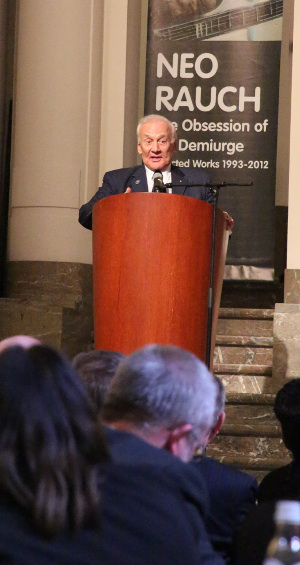
The topic of sustainable life support was given a healthy dose of attention. For human star flight, this is an unavoidable imperative whose methods must achieve 100% recycling. This forces achievements beyond what is necessary for Moon and Mars bases. In addition to the obvious issues of sustainable biology and human physical health, issues such as clothing manufacturing and recycling, governance methods, and questions about what cultures and individual life experiences would be fitting for an interstellar world ship emerged in these discussions.
Image: Buzz Aldrin addresses the guests during a dinner session. Credit: Ronke Olabisi.
While some might think that issues like these can be postponed until we are closer to the goal, remember that all humanity is trapped on a spaceship with a malfunctioning life-support system (human-induced climate change) right now, along with a radiation shielding system whose permanence is not guaranteed and a ‘crew’ that is largely oblivious to their responsibility for maintaining the habitability of spaceship Earth.
But all is not dark despite such gloomy prospects. There were also plenty of discussions about using the goal of star flight to provide a positive view of the future, something to allow us all to thrive, not just survive. For example, one talk suggested that we use the context of the love for our children to frame this positive future view. It was interesting that the person who made this comment, Jennie Yeung, also made the observation that she was the only Asian in this interstellar session and that Asians represent roughly half of the population of starship Earth.

Image: The European Union session at work. Credit: Marc Millis.
Sustaining Spaceship Earth, and learning how to create more world ships, calls for a world-wide endeavor. The focus of subsequent discussions was, “What do we do next?” Recall that at our present rate of procrastination, two-centuries remain before starflight might become possible (not including precursor missions). What is not known is if human society will survive long enough to achieve that sustained survival ability. Amongst the speakers, deep thinkers in their own right, there was frank discussion about such unknowns and what we can each do to make a better future. While Mae Jemison assembles a proposal to the European Union for interstellar work, the individual speakers discussed amongst themselves how to collaborate and what we can each do as we pursue our own specialties to make relevant progress. Despite the encouraging invitation from the European Union that puts the focus on these possibilities, there is no guarantee that there will be funding for this type of work.
The effect of star flight on society was also discussed. First, when considering the levels of energy needed to achieve interstellar flight, our civilization will have had to have achieved sustainable peace amongst ourselves. Even a slight misuse of these levels of energy could destroy the entire surface of Earth. Humanity must mature to have the responsibility to use such prowess safely.
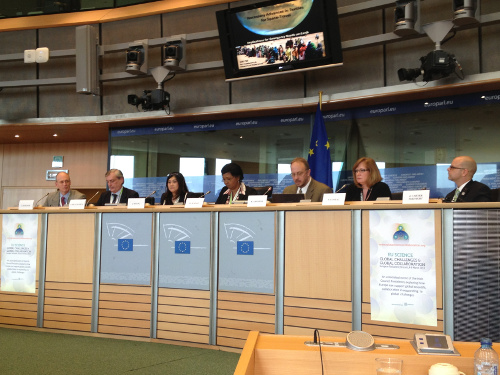
Image: Speakers’ stations at the meeting. Credit: Marc Millis.
John Carter McKnight, Kathryn Denning, and others articulated the dimensions of the ethics and regulatory issues involved in moving towards interstellar capabilities. And when it comes to how to tell the story of the values and risks of interstellar flight, Kathryn Denning suggested that we avoid using some common analogies that have been popularized to discuss spaceflight. Specifically she cautioned against analogies to Columbus and Magellan, since these events of discovery also included some of the uglier sides of humanity, such as greed, mutiny, and slavery. In short we need to create a new positive message that accurately conveys the opportunities risks and sensible steps to eventually achieve both the societal maturity and technological capability of star flight, and in so doing, vastly improve life on Earth.
In the meanwhile then, while we all wait for our ideal levels of funding to come in, we shall continue ad astra incrementis, to the stars in ever-increasing steps.
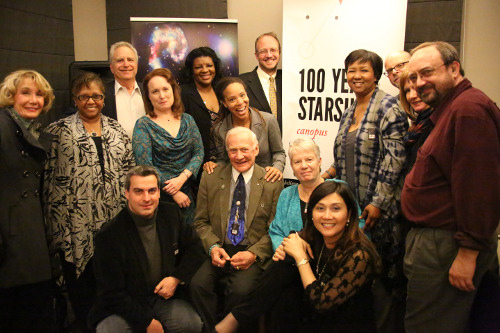
Image: A group shot following discussions on the 100 Year Starship project in Brussels. The front four: Marsal Gifra, Buzz Aldrin, Jill Tarter, Jennie Yeung. In back curving from left to right, Kathleen Colgan, Gwen R. Artis, Lou Friedman, Kathryn Denning, Alires Alimon, Ronke Olabisi, Karl Aspelund, Mae Jemison, John Carter McKnight, Pam Contag, Marc Millis. Credit: Ronke Olabisi.

Into the Orion Arm
Although we have little observational data to go on, the existence of the Oort Cloud simply makes sense. We see new comets coming into the inner system that are breaking up as they approach the Sun, obviously not candidates for long survival. There has to be a source containing billions of comets to account for those we do see. The Kuiper Belt is stuffed with what we can call ‘iceteroids,’ all moving more or less along the plane of the ecliptic until, well beyond the Kuiper Belt itself at about 10,000 AU, the disk shaped belt of material spreads into the spherical Oort Cloud. A nudge from a rogue planet or passing star is enough to produce the velocity change to send a comet inward.
We’ve been looking this week at possible human uses for cometary objects, including the fact that they’re rich in water but also nitrogen and carbon wrapped up in interesting organic compounds. From the standpoint of resource extraction, we also find interesting elements like silicon, sulfur, nickel, chromium, magnesium and iron available in at least small amounts. Tiny worlds a few kilometers in diameter, rich in resources and loaded with water, existing by the trillions. Surely a space-oriented civilization of the future will find a way to exploit them.
Protecting the Inner System
But it’s likely that long before we start talking about a human presence in the Oort Cloud, we’ll be engaged in robotic studies driven by the sheer necessity of protection. Recent near-miss asteroid events have raised public consciousness about near-Earth objects that could pose a threat to our planet. Comets can wreak havoc as well, with the difference that near-Earth objects are gradually becoming tracked and catalogued. With an NEO, we can plot trajectories that give us time to consider how to move an object that might not be projected to hit for decades.
Comets are different. We can’t predict when a new one is going to appear. Robert Zubrin points out that when the huge comet Hale-Bopp was detected in 1995, it was well beyond the orbit of Saturn, but moving at a speed sufficient to cross the Earth’s orbit a mere two years later. An object like this, massive and moving at high velocity, would have been all but impossible to deflect if we had learned it was headed for us. Deflecting a fast-moving comet, as opposed to a nearby asteroid, means getting to it when it is still deep in the outer system. Planetary protection will all but ensure we’ll have a presence in the Kuiper Belt and Oort Cloud one day.
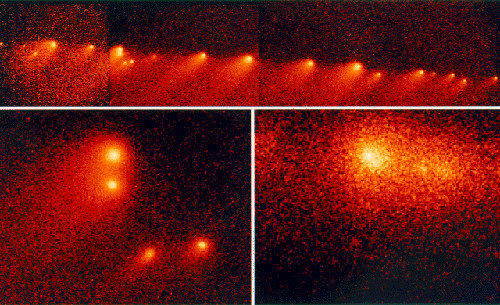
Image: Comet Shoemaker-Levy 9, torn into pieces as a result of a close approach to Jupiter in July 1992, before its later impact with that planet. The major cometary fragments range in size from one to a few kilometers. Credit: JPL.
Whether such a presence is largely robotic or not, it will spur the technologies we’ll eventually use for starflight. And not just the technologies — as we’ve seen, human settlements on O’Neill cylinders exploiting cometary resources would be case studies in isolation and social experimentation. Starships designed for fast crossings (multiple decades) or gradual voyaging (thousands of years) will have to incorporate what we’ve learned about people working together to keep communities in coherence when far from home. The Oort Cloud has a role to play.
The Fork in Interstellar Evolution
It’s possible that we may see two kinds of starflight in the next thousand years. I turn again to Richard Terra, whose article “Islands in the Sky” ran in the June, 1991 issue of Analog (it’s also reprinted in a 1996 hardcover from Wiley with the same name, a volume of essays edited by Stanley Schmidt and Robert Zubrin). Terra’s notion is that the wealthy inner system cultures will eventually develop what Ben Finney calls ‘fastships,’ spacecraft capable of moving at a substantial percentage of the speed of light. These will always be the first to cross the interstellar divide, but a slower wave of migration will follow.
The point is this: A small but growing human population in the Oort Cloud will master cometary motion, taking advantage of the fact that at 10,000 AU, the speed needed to orbit the Sun is just 300 meters per second. Compare this to the Earth’s 30,000 meters per second and it should be obvious that it takes only a small change in velocity to alter a comet’s orbit. We’ll have learned this in theory if not in practice because it factors into the engineering needed to divert a potentially dangerous comet from striking our planet decades in the future. Learn how to bump comets to change their orbits and you start thinking about what else you might do with such an object.
Interstellar space must be littered with comets that have been ejected from our system through the 4.6 billion years of its existence. Some estimates run as high as 1000 Earth masses in cometary material, so the resource base between us and the nearby stars should be plentiful. If Oort Cloud comets are separated by about 20 AU, these interstellar comets may be hundreds of thousands of AU from each other. The Oort Cloud should be in perpetual flux as some interstellar comets enter and move through it while other comets are pushed back out.
Let me quote Terra on this:
Some of these interlopers are bound to be found within Sol’s own Oort Cloud, working their way free of the Sun’s grip, at perhaps one in every several thousand. Relative velocities between Solar and interstellar comets will be low, and it will be tempting for Oort Cloud residents to hitch a ride outward — perhaps farther out into the permanent Cloud, perhaps out into interstellar space. Drifting outward at about 10 km/s or about 2 AU per year, they will make slow progress indeed. In 50,000 years they will be halfway to the nearest stars. But by then they will be wholly adapted to life in interstellar space and will perhaps not be too concerned with visiting other star systems.
So maybe there’s no one way to depict interstellar expansion. Fastships propelled perhaps by fusion or beaming technologies or antimatter may eventually cut the journey to decades. Over the millennia, a species fully adapted to living in space — and surely evolving in ways we’ll be unable to predict — will populate the outer system and move in slow generation ships between stars that may no longer be so much a destination as a curiosity. Perhaps some Oort Cloud communities will, as Terra suspects, alter a comet’s orbit so as to make a gravity assist maneuver around the Sun, all the while shielding the nucleus with solar power collectors.
Gravity assist might pick the speed up to 150 kilometers per second, which works out to a bit over 8000 years to Alpha Centauri. Whether such a traveling colony world would actually put colonists on a planet around the destination star is conjectural. Perhaps more likely is the idea that they would study the new solar system and then set course for another. The human species will be in the process of evolutionary forking, and after a few such journeys between the stars, the meeting between the cometary travelers and their fastship brethren would be an interesting one to see. What would these two different branches of humanity still share?
I don’t know the answer to that question, but it gets at the meaning of what it is to be human. Our future Oort Cloud dwellers will have not only an isolated gene pool but the tools of genetic engineering at their disposal, which could make biochemical and even structural changes possible at a faster clip than straightforward natural selection. If our species survives its technological adolescence — by no means a sure thing, as the Drake Equation reminds us — then humans around other stars are going to take a wide variety of forms adapted to their environments, a flowering speciation that could spread humanity out into the Orion Arm.

